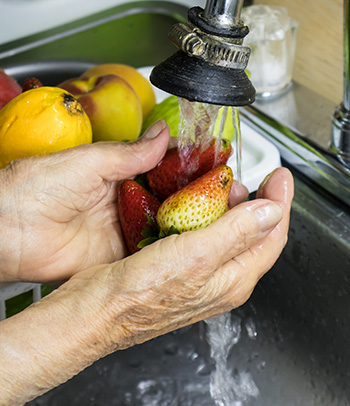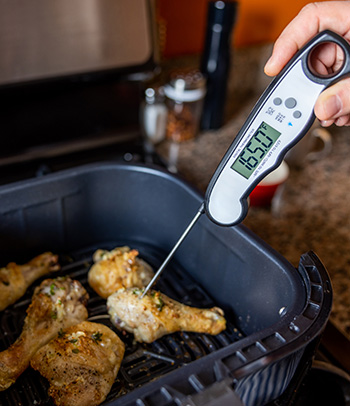Food recalls in the news can be worrisome, but armed with the right knowledge, you can keep yourself safe!
Food recalls seem to be all over the news these days. Don’t eat that spinach! Throw away your carrots! Watch out for eggs and bird flu! There are stories about people getting sick from listeria and salmonella. What does it all mean? How can we ensure the food we eat is safe?
Take a deeper dive into the world of food recalls and learn about why they happen and what steps you can take to keep your food safe.
What Is a Food Recall?
A food recall occurs when a company removes a product from the market because there is a reason to believe that it may cause consumers to become ill. According to FoodSafety.gov, this can happen for different reasons, including:
- Discovering disease-causing microorganisms, such as bacteria, viruses, or parasites.
- Finding the presence of foreign objects, such as broken glass or metal or plastic fragments
- Failure to list a major allergen on the product label, such as peanuts or shellfish
Recalled foods are usually initiated voluntarily by the food manufacturer or distributor out of an abundance of caution. But sometimes the recall is requested or mandated by the organizations that regulate our food–the U.S. Food & Drug Administration (FDA) or the U.S. Department of Agriculture (USDA). In both cases, regular testing helps detect harmful germs that can infect our foods and drinks for humans and pets.
Recalled foods can cause illness or injury, especially for high-risk groups such as people who are pregnant or who have weakened immune systems.
How Does Food Get Contaminated?
Food goes through several steps from where it is grown or made to your kitchen. Contamination can occur at any point along the production chain–during production, processing, distribution, or preparation. Here are some examples:
- If contaminated water is used to irrigate, wash, or chill fruits or vegetables, the contamination can spread to those items.
- During an animal’s slaughter, germs from the skin or intestines can get into the final meat or poultry product.
- If germs contaminate surfaces such as a processing line or a storage bin, germs can spread to the foods that touch those surfaces.
- A sick food worker could spread germs when preparing food if they do not wash their hands properly.
What Steps Should I Take if I Have a Recalled Food?
- Don’t panic. Many recalls are voluntary and done as a precautionary measure. There may be potential for the food to be contaminated, but a recall doesn’t necessarily mean that there’s a full-blown outbreak with people getting extremely sick.
- Check the recall notice. Recalls are very specific, meaning all the information must match for a product to be considered part of a recall, including brand, product name, use or freeze by date, etc. If the product details in the recall match your item, do not open or consume the food. The recall will provide instructions on what to do with it. It may ask you to return the recalled food to the store where you bought it for a full refund, or it may direct you to safely dispose of the product so that other people or animals cannot eat it. If the product doesn’t match the information in the recall completely, then it’s not part of the recall and is safe for use. When possible, store foods in the original container or cut out the label so you will know the lot number.
- Don’t eat or open the food. It’s always better to be safe than sorry. If a food is recalled, don’t open or taste it to “see if it’s bad.” Bacteria and viruses you can’t see may make you sick or contaminate your refrigerator or kitchen. Follow the instructions on the recall for disposal and be sure to thoroughly wash your hands after touching the recalled product.
- Clean. Clean any surfaces that may have been in contact with the contaminated food. Germs in the recalled food can spread to other areas, including the shelves or drawers in your refrigerator. If you’ve already prepared the food, clean any countertops, cookware, cutting boards, or utensils that came in contact with the food as well. Learn more about how to properly clean after a food recall.
- Stay informed. Real-time notices of recalls and public health alerts are listed on both the USDA and FDA recall pages. You can scroll through the items listed and click on a specific recall or alert for more information. You can subscribe to receive email notifications from the FDA regarding recalls. The Centers for Disease Control and Prevention (CDC) also posts notices for multistate foodborne disease outbreaks.
How Can I Practice Good Food Safety at Home?
While we can’t control what happens during food production, we can control what we do within our own homes to keep our food safe.
- Clean. Wash your hands and surfaces often when you’re dealing with food. This includes before, during, and after preparing food, as well as before eating it. This is especially important after handling uncooked meat, poultry, seafood, flour, or eggs. Utensils, cutting boards, and countertops should all be washed with hot, soapy water after preparing food.
- Rinse. Some foods are more prone to recalls and should be rinsed before consuming. For example, fresh produce with a lot of surface area, such as thin leafy greens, has more space for bacteria to grow. Rinse your fresh fruits and vegetables under cool, running water for at least 10 seconds to help remove germs. Be careful not to splash water around the sink, if you rinse chicken.
- Refrigerate. Bacteria can multiply rapidly when food is left at room temperature. Don’t leave perishable food out for more than two hours.
- Cook meat thoroughly. Use a meat thermometer to cook your meats to the correct minimum internal temperature to help kill any pathogens. Check out this chart for a detailed list of safe temperatures and foods.
- Don’t cross-contaminate. When you prepare food, your meats, fresh fruits, and vegetables should not be prepared using the same cutting boards or utensils. When you shop, keep raw meats, seafood, and eggs separate from other foods. Store marinating or raw meats in sealed containers away from other foods in your refrigerator. Storing new food with old makes the expiration date that of the older food.
- Watch for signs of food poisoning. If you’re concerned you may have ingested food that was unsafe, watch for common symptoms, including fever, cramping or abdominal pain, nausea, and diarrhea.
Food recalls in the news can be worrisome, but armed with the right knowledge, you can keep yourself safe!







